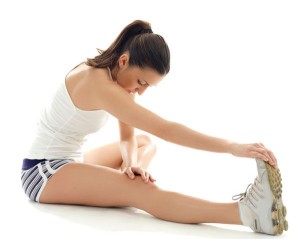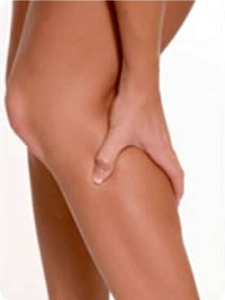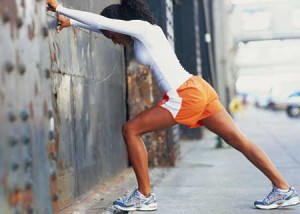 Last month, I wrote an article that took a look at how stretching makes us slower. There were some good follow up questions to that article. I think after reading it, most runners understand how stretching has a detrimental impact on running economy.
Last month, I wrote an article that took a look at how stretching makes us slower. There were some good follow up questions to that article. I think after reading it, most runners understand how stretching has a detrimental impact on running economy.
However, many wondered: Is that enough reason to stop stretching? What about all the benefits? For example, what about stretching and its role in preventing muscle soreness?
Well with today’s article I want to clear up a very common misconception. It is a topic that I have written about before in my blog. Here it is:
Stretching does NOT help to prevent muscle soreness.
Before I start, I would like to reiterate that I am not anti-stretching. There are valid and important reasons to stretch. That being said, there is no doubt that preventing muscle soreness is not one of those valid reasons.
When I first started to look into this line of research many years ago, I admit I was skeptical. We were always taught that lengthening a muscle will make it a more supple tissue and ready to respond to exercise, and thus, less likely to be sore.
However, study after study has consistently shown that whether you stretch before or after exercise, that acute bout of stretching will not have an impact on the muscle soreness you feel over the next 24-48 hours (otherwise coined ‘delayed-onset muscle soreness,’ or DOMS).
Don’t believe it? Let’s go right to the gold standard of medical research: The Cochrane Database. If you have never heard of it, this is where researchers compile medical research, rate their quality, pool the results, and draw conclusions at the highest standard. With such a high standard of analysis, reviews published in this journal often don’t reach any conclusion at all and state, “more research is needed.”
On that note, check out this review from Cochrane looking at the role of acute stretching on DOMS. After compiling the results of the highest quality studies that met their inclusion criteria, they showed that:
-On a scale of 1-100, pre-exercise stretching reduced DOMS by 1.5 points
-On a scale of 1-100, post-exercise stretching reduced DOMS by 1 point
Can you tell, in a reliable and reproducible way, if you are 88/100 vs. 89/100 on the soreness scale? I sure can’t. In fact, I was surprised that the placebo effect of stretching didn’t make more of a difference. But the review makes it clear: stretching did not impact muscle soreness.
The researchers agree as they state, “The evidence from randomized studies suggests that muscle stretching, whether conducted before, after, or before and after exercise, does not produce clinically important reductions in delayed-onset muscle soreness in healthy adults.”
So now it’s time to make sense of WHY stretching doesn’t help us feel less sore. Growing up, we were taught that a nice stretch will make the muscle better equipped to handle the loads of exercise. The truth is that this may make sense at some level, but not in the realm of DOMS.
The way this train of thought MAY make sense is in isolated cases of injury prevention (*note, general stretching is not a good way to prevent general injuries, but that is for another day). For instance, if you are a gymnast, and you know your left hamstring is hypo-mobile (not flexible enough), and you are going to be performing tasks that require a huge range of motion within that hamstring, stretching that tight tissue to establish sufficient range of motion may help to prevent an acute tear. That is preventing a muscle tear, NOT preventing DOMS.
I think this is the way we often believe stretching helps to prevent muscle soreness. However, once we take a closer look at what stretching does to our muscles, what exercise does to our muscles, and what DOMS actually is, it becomes clear why stretching does not help prevent DOMS.
DOMS is quite different than a muscle tear or strain. With DOMS, we tend to feel the worst 1-2 days after the activity, while an acute strain will typically be felt instantly. In addition, DOMS is usually more generalized in contrast to a more specific region as felt with a strain.
DOMS occurs because of microtrauma to the fibres that make up our muscles. If we look at these muscles with diagnostic imaging like MRI or US, we can’t see that anything is wrong with them. However, at the microscopic level, the muscle is beat up. This microtrauma is a good thing; it is one of our goals with training, and yes it hurts short term, but the muscle will adapt and become stronger as a result. By contrast, a strain or tear involves more significant damage, and a local area of tearing and inflammation can usually be visualized with diagnostic imaging.
Now, stretching- what impact does it have on muscles? Looking at things on a larger scale, yes stretching increases range of motion. However, if we look at things at a microscopic level, like exercise, stretching also produces microtrauma of the muscle. It’s not an injury, but it’s enough to cause damage to our muscle fibres.
So why would stretching (aka microtrauma) help decrease the symptoms of DOMS (aka microtrauma)? The answer is simple: it doesn’t.
Some studies have even shown that stretching, if done excessively, may INCREASE the DOMS we experience. This makes sense: induce microtrauma to a muscle (stretching) that is sore because of microtrauma (exercise), and soreness goes up.
Now it should be clear: stretching doesn’t prevent soreness, stretching might make us more sore, and it also makes us slower.
On that note, it is important to recognize that there are reasons to stretch. As I said in my previous article, if there is an area of inflexibility that is causing an injury or an inability to complete a task that you need to do, then stretching is useful! If you are stretching because it feels good, then go for it!
However, if you are stretching to prevent soreness, then it’s time to reconsider. Stretching, may have benefits, but reducing DOMS is not one of them.
Dr. Sean Delanghe, BSc. (Hons), DC is chiropractor and coach who is a regular contributor to the RunWaterloo blog.




